This “How To” page will evolve. It starts with a collected sampling of posts from Bob Graf’s “Diary of a worm”, which provided details about how a home version of the Growing Power system of small-scale agriculture works. These posts will be edited and updated and eventually reworked into a self-contained page of instructions and tips.
Here is a video/music background of this home model project to date:
http://www.skyalbum.com/showAlbum/70538
An Overview of the System
(Updated From Diary of Worm Posting Nov. 6–8, 2006)
A friend from Maine is in town and yesterday was over, interested in the Growing Power system. He suggested that perhaps it is time for me to go back over the basics of the “same old, same old” of this system of growing.
Early in October of 2006, for those of you interested in math, I gave you a formula for Growing Power. It was: Wood Chips + Coffee Grounds + other waste = compost > worms < castings + compost + coir = growing soil + seeds + tea + sun + rain = plants > vegetables, flowers and herbs. I promised to spell out the formula in words and picture and here it begins.
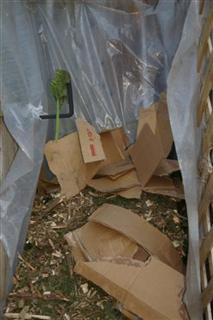
Wood chips/Carboard +
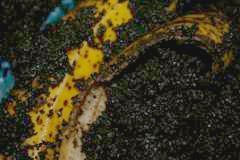
Coffee Grounds/Banana Peel =
Compost
Wood chips stand for carbon, which could be leaves, cardboard, paper or many other forms of waste. Coffee Grounds stand for nitrogen, which could be brewer’s waste, kitchen waste from fruits and vegetables, or many other forms of vegetation waste. When the nitrogen and carbon are put together in a pile, with air and water, they ‘cook’ and form compost.
Wood Chips + Coffee Grounds + other waste = compost > worms < castings + compost + coir = growing soil + seeds + tea + sun + rain = plants > vegetables, flowers and herbs.
Yesterday we discussed and pictured the the first part of this Growing Power formula. It was carbon plus nitrogen waste equaling compost. After the compost cooks for a while, naturally, it breaks down to a soil-looking kind of substance. Now it is ready to feed to worms. Outdoors this happens in a wood box I called a “worm condo”, and inside it happens in the Growing Power box. Each worms eats its own weight each day. As the compost passes through the worms it is enriched with hundreds and hundreds of healthy living organisms. I am not up on all the good stuff that happens to compost, but I do know that even the worst kinds of organisms like e coli are replaced, as they pass through to the worms, into healthy organisms. There is a lot of scientific information on this process and once I know about it I will pass some onto you.
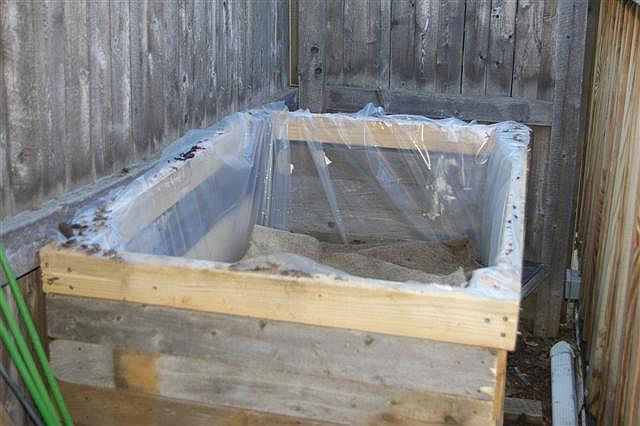
Worm Condo+
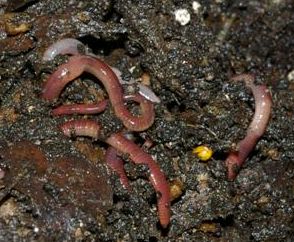
Worms >
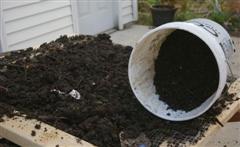
Castings
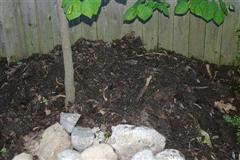
Worm DepositoryWorms are at the heart of the formula. They are very consistent and focused creatures. They eat, produce castings and multiply. They are unisex creatures, so they multiply quite easily. In my worm depository they just keep eating and multiplying…
Also, worms are low-maintenance livestock. You just need to make sure they have enough food (compost) to eat, digest and cast off, and they stay focused and working. Worms in the worm condo are extracted by putting an ordinary screen over the box with fresh compost on top. Worms do not eat their own castings, so they will come through the screen for fresh compost. A few times of this and the castings in the box are ready for use in growing.
Wood Chips + Coffee Grounds + other waste = compost > worms < castings + compost + coir = growing soil + seeds + tea + sun + rain = plants > vegetables, flowers and herbs.
Once we move through the worms to the castings, the Growing Power equation becomes more familiar. Growing Power mounds, planters, and boxes like in my sun-room contain some combination of castings, compost and coir (coconut shavings). These combinations become the soil in which the seeds are planted. The casting are rich in organisms; compost, if used, keeps the worms working in mounds, and coir, like the less-sustainable product peat moss, maintains moisture in the soil. The combination depends on the type of growing — box, planters, or outside mounds.

Castings+
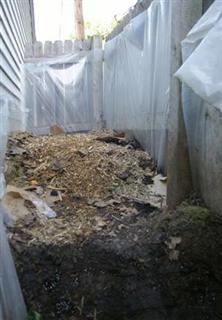
compost +
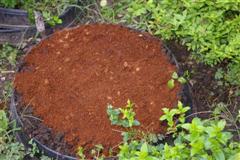
Coir
Now that we have the base soil, we just need to add seeds, water with tea (rain water or tap water that sits for a day, strained through castings), and add some sun and/or growing lights, and we have healthy, organic, affordable vegetables, flowers and herbs.
=
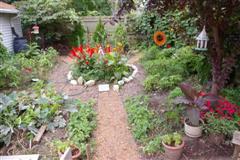
Gardenor
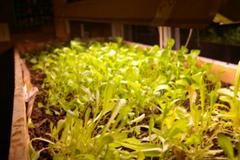
GP box or
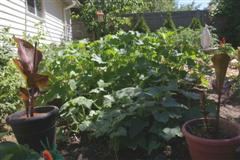
Mounds
The picture above of the greens in the Growing Power Box in the sun-room was taken tonight after I cut off some salad greens for dinner. This affordable and organic food is the real end result and the rest of the story.
back to top
Growing Soil
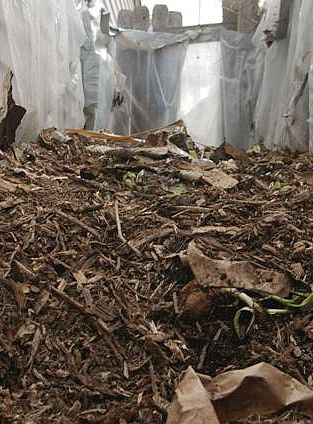
Watch soil grow!Today I added a little to my small compost pile that will grow and shrink again. It is the first step in developing a Growing Power garden. Waste becomes compost, which becomes rich soil to be used in the row mounds in the garden and for worms to enrich into ‘black gold’. Compost is made with layers of carbon, (cut up boxes and newspaper, leaves, wood chips) and nitrogen, (coffee grounds, brewer’s waste, vegetable scraps, grass). These items are mixed, cooked and grow by shrinking into rich soil. All you need is a large space that is contained, well-aired, and watered if there is no rain. The pile cooks from the inside, generating heat as it compacts into rich soil. This pile pictured above is open on one side, closed on the garage side and has some air holes in the plastic on the two fence sides. The mixture some say should be 50/ 50, but now Will and Growing Power are saying 75% carbon and 25% nitrogen.
This year I am growing soil in an area 12 ft. long, 42″ wide and up to 58″ high. So far I have on the ground layers of ripped out boxes, lots of coffee grounds, leaves, crushed vegetable waste from a dumpster behind a grocery store, a little brewer’s waste, lots of wood chips, and saw dust. Beside my own leaves and grass I get some from neighbor. On my grocery-shopping rounds I stop at coffee houses for grounds, the dump for wood chips, and the dumpster behind the grocery store for food waste. Always make sure the top layer on the pile is carbon (wood chips, leaves, or cardboard) to prevent animals from eating the nitrogen material and to cut down any odor from deteriorating vegetable waste.
So all this waste becomes naturally rich soil. It cooks, so to speak. You can speed up the process by turning it over with a pitchfork. After a while, when it has partially cooked, I could put worms into the compost to enrich it, but it is more efficient to use the compost to feed worms in the worm depository, to use some of it to make a base for mounds and planters, to put some in the worm condo, where worms take the rich soil and make it into worm castings or “black gold”, as this enriched soil is called in GP.
By turning our waste into compost and enriching it with worm castings, we can grow, in a very small space, in all kinds of places, and in all kinds of conditions, healthy food for every man, woman and child. America has the most waste of any nation, so it is right and just that we be leaders in this urban agriculture. If we could spend just one fraction of the resources — human and financial — that we spend on violence, on turning our waste into into soil to grow healthy food instead, we all would be richer for it.
Like my wife says about basil, I say about waste to growing compost, “You can never have enough.”
back to top
Same Old, Same Old!
If you are a regularly reader of the Diary of the Worm you have probably heard me many times refer to the “same old, same old”. This is a term I picked up from Will Allen that describes the basic underlying method that pervades all ways of using growing power — in planters, mounds, or in the Growing Power Box.
The basic method, “same old, same old”, is a base of rough compost topped with worms with a mix of castings and coir (coconut shavings) on top. These are same variables in this “same old, same old, GP mix like a small planter just having a mix of castings and coir or mounds not using coir but basically this is the combination of items that pervades all the various forms of Growing Power be in rual, city farming or gardening.
The underlying rough compost (cooked a little) provides food for the worms. The worms eating the compost cast off new energy for plants. The castings and coir is the growing environment in which the seeds are placed. The castings provide the nutrients the seeds need to grow and the coir (coconuts) shavings) provide the moisture absorber the plants needs.
Coir is a sustainable product since there are two coconuts for every human being in the world and thus an endless supply. Peat moss, which is often used for same purpose is not a sustainable product. Once it is used it does not come back.
Making soil/compost is explained above and of course castings are producing from worms eating the compost. There will more about worm castings to come. Worms eat their weight in compost each day and thus are very productive livestock.
”Who takes care of your worms when you are away?”
This is a good question. The answer is at the key to Growing Power with worms. The answer is that worms, except for occasional feeding and providing water are very low maintenance livestock. Worms in my worm depository, worm condo, and growing power box only need enough food (compost) and water so they do not escape (worm depository) or die (worm condo and GP box in sun room. For example, for the winter I just build a big pile of food in the backyard, cover it with leaves and wood chips and all the worms in the depository live in the warmth of the compost eating it, and drinking the rain or snow that leaks down all winter along. In the summer I just add food, like coffee grounds and water to the hill about once a week or so. The worms in my condo, working to make castings, just need to be removed when the food runs out, since they do not eat their own castings. I either put them back in the box with fresh food and keep the cool with a burlap topping of box and watered if it does not rain. Or if it is winter I put them in to the Growing Power Box in the sun room with plenty of compost for the winter months and when I water the plants growing in the box they get water. So you can see who ‘low maintenance worms’ are.
Also they are wonderful livestock since they are unisex and are, in right conditions, constantly reproducing. The eat their weight each day in compost (soil made from waste that is enriched) and make it 13 times more enriched living healthy organisms. Also from tier castings you can make a “tea” like substance that is excellent organic fertilizer.
Worm Condo
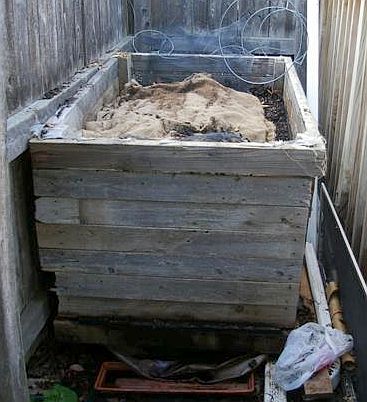
Worm CondoI am not sure how the worm box that is used to have worms make castings became called a “worm condo.” I think it was sometime when a group of volunteers built the sophisticated system of connecting worm boxes, which are in one of the greenhouses at Growing Power, that have a central storage tank for the drained tea.
The main purpose of the worm condo is to be a work area which worms can eat compost and produce castings or “black gold.” Castings are valuable growing soil that can be used to grow plants in, fertilize plants or make “tea.” A “worm condo” is a valuable asset to every home model GP garden or community garden on vacant lots in the city.
Our worm condo is outside, a single unit, and was built by my son’s friend Loren in the spring of 06. It is more like Will Allen’s original ones. It is made from scrape wood and is 34″H X 34″W X 54″L. The box is off the ground and the back post are higher than the front. There is a plastic liner under the box and and the base of the box have open spots.
Thus the water placed in the box goes through this enriched soil and becomes tea that leaks out the bottom and down to a catch basin in front of the worm condo.
In the box rough compost (soil made from waste) is placed along with a number of our worms. In our home garden we take the worms from the Growing Power Box inside, and put them with the compost in the ‘worm condo.’
The box is on the side of the deck that gets the least sun. We have burlap on top of the compost, and we water it daily. It takes about two months for the worms to eat all the compost. When the soil becomes mostly castings it is time to take the casting out. However, first the worms need to be removed.
This is accomplished by putting a regular fine screen, like used in windows and doors, over the top of the box. On top of the screen put fresh rough compost. The worms will slowly craw up through the screen for the fresh food. After a few days you remove the compost on top of the screen that is full of worms. Compost and worms can be placed in worm depository outside or in GP Box inside. Repeat this process three or four times and about 90% of the worms will be removed leaving rich castings.
Castings are the rich by-product of worms that contain all kinds of living organisms that are health for plants and flowers. The castings are very valuable growing material, selling wholesale at about $75 a five gallon bucket. In the G.R.A.F. system the castings are used to make ‘tea’, to direct place around the plants as fertilizer and to create the “Same Old, Same Old” (see above) soil that is at the heart of Growing Power. By filled the box with compost in early spring, this year, 07, so our worms can create two boxes of valuable worm castings this spring and summer.